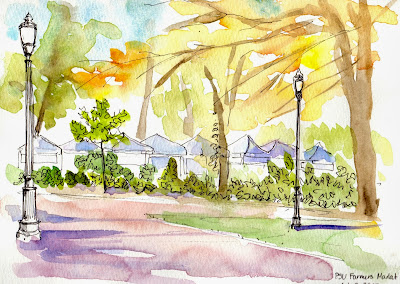The wonder is that we can see these trees and not wonder more.
-- Ralph Waldo Emerson
Well, I have been wondering a lot about trees lately. Specifically, I've been wondering how to draw and paint the gorgeous gold and red trees around town. I've been looking at examples in books and online and practicing trying to replicate other's paintings (especially Shari Blaukopf . Sometimes I drew branches first and then painted and other times, I put down blobs of paint and then added the branches. A few times, I added splashes.
I've been to some of my favorite spots, like the south park blocks...
and I've painted from the car when the weather's been bad...
This weekend, by request, the Urban Sketchers of Portland concentrated on trees, looking at examples and discussing techniques.
Some tips that I learned are:
Sometimes landscape designers and architects begin trees like maples, with three overlapping circular forms. The main branches are shown where the circles overlap.
Deciduous trees seem to have rounded forms on the top curves and more pointed edges below.
Sky holes (a delightful new term to me) are usually in the less dense parts of the tree.
When drawing only, beginning with the branches first helps give the shape of the tree, but with watercolor, it works best to start with the colored forms and later add the branches.
Then we went out into the neighborhood of Ladd's Addition and put our new knowledge to work.
I still have a lot to practice, but I don't mind because it means I'll spend lots more hours staring at and wondering about our magnificent trees.
.........
I frequently tramped eight or ten miles through the deepest snow to keep an appointment with a beech-tree, or a yellow birch, or an old acquaintance among the pines. ~Henry David Thoreau
A special thanks to the trees that have been used for my sketchbooks.


























